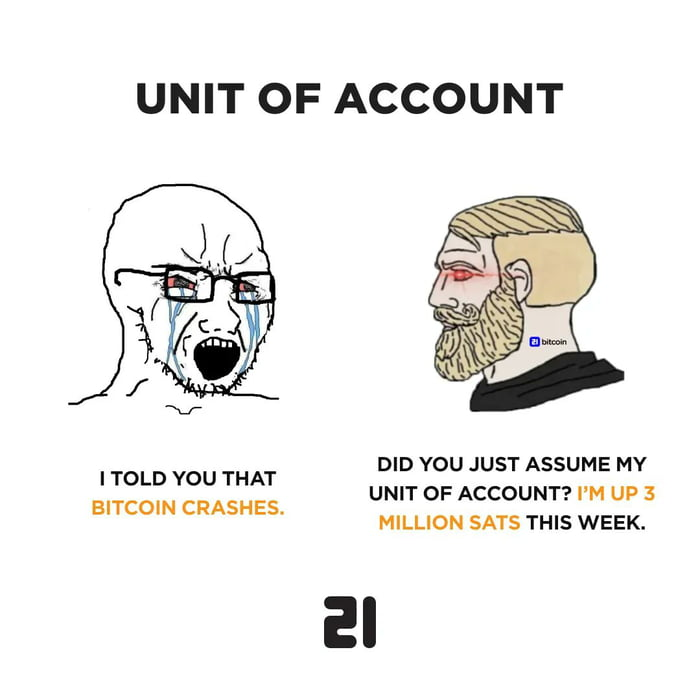Debates about how wider adoption of Bitcoin will occur are popular among bitcoiners, though not all that useful. Personally, of course, I have no idea how it will happen, but it’s nice to talk about a few schools of thought as they have a broader worldview connections. And since our eyes only see and our ears only hear what our brains are looking for, I’d like to highlight the underrated but, in my opinion, most important modes of adoption. But before that, let’s consider what the criteria for the success of Bitcoin are – when do we say adoption is successful? What are we moving towards?
The success criteria of Bitcoin (adoption)
Opinions differ on the success criteria, as well as on the best path to Bitcoin adoption, and are interrelated. I’ll start with my controversial view that Bitcoin is already a successful project. If Bitcoin hadn’t already gone anywhere in terms of services, liquidity, or adoption, it would still work just as well for me, my social circle, and my use cases. The only condition is that there is no major regression – especially in services and adoption. Services come and go, so Bitcoin certainly has no long-term win here – especially with regulatory attacks. And adoption may decline, although with fiat failing around the world at the moment, I don’t see that as a very likely scenario. And the technology is virtually only going forward – of course, the current technology may not be sufficient for future challenges, such as scaling or security budget.
But in principle I am satisfied, and if Bitcoin stays approximately the same (I do not count even with “growth” – that is, development in all levels, only with stagnation), I am satisfied.
Bitcoin brings protection from confiscation, over-taxation, inflation, capital restrictions (easy transfer across any border) and regulatory hell. Other criteria for success that I personally don’t consider important, but are common, include:
Expressing prices in BTC or sats
Although some companies (e.g. liberation.travel) and services (e.g. Nostr) already quote prices in Bitcoin / sats, or use BTC as a unit of account, I personally don’t think that this is a success criterion. Changing the unit in which we think about value is difficult. I grew up in Slovakia, where we changed currency from Slovak crowns to euros. For several years, people still calculated the Slovak crown value of goods and services using the euro exchange rate – into a currency that no longer existed! With today’s technological means, it is not a problem to convert prices.

Nowadays, the conversion is done automatically in a convenient (acceptable) way for me and I don’t have to deal with it.
Communication of value is just about displaying it in the app – for example, someone makes a Lightning invoice in Czech crowns, I put it in my wallet (or scan the QR code), see how many dollars (euros, grams of gold, …) it is and click send.
When I used to do long term financial planning, I have used grams of gold as a unit of account. The reason was that I didn’t want to recalculate the plan every once in a while based on price inflation, which was unknown to me in advance. So gold was a useful unit for me to think about value, even though I did most of my purchases not in gold, but in Slovak crowns and later in euros. Or to put it another way – if I see prices in dollars in Panama, and pay in euros with my card, does that mean that the euro is a failed project, just because no one in Panama lists euro price on the price tag?
In this case, of course, the vendor gets dollars. But what about the Czech Republic, where almost everywhere I can pay with euros in cash, even though not a single price tag is in euros?
Institutional adoption as a success criterion

The institutions that should “adopt Bitcoin” are of two types. The first are companies that save in Bitcoin or hold it as a reserve. The bigger the firm, ideally publicly traded, the better. It’s an acknowledgement by a large corporation that we’re doing something right. From my perspective, an uninteresting criterion. The fact that a corporation bought bitcoin is nice, but it doesn’t mean anything fundamental to me.
The other type of institution that could start using and offering Bitcoin are large funds. With them, you can buy bitcoin “on the exchange”, like an ETF. Apart from minor tax advantages (time test) in some countries, I don’t find this way of buying Bitcoin useful – you deprive yourself of almost all the good features of Bitcoin. Institutions offer this product to earn fees on it. It does not mean they trust it, they are selling it for a fee! They sell tons of products in order to make their trading fees.
For Bitcoin, this is not a success criterion – there are various institutions that make money from selling Bitcoin, such as exchanges. Whether it is Blackrock and Vanguard, or Kraken and Coinbase making money on the sale, I personally don’t care.
Adoption by states, “good” regulation
The wet dream of adoption is when a central bank starts using Bitcoin as a reserve asset, or states start buying it for their treasuries.

Image: the central bank (Slovak branch of ECB) having switched to Bitcoin. At least for a few seconds. From the movie (En)light(enment) to the Banks.
States are competitors to the parallel financial system. While something like this would be an admission that Bitcoin is cool, on the other hand, we really don’t need recognition from institutions that can’t even meet their own inflation target, and have been impoverishing the population for a long time. A lot of people see regulation as a criterion for success. To be told by the state with their regulatory magic wand, that you can use it and it’s a good idea is not a success. States are dumb institutions and their “recommendations” or “regulatory approval” mean nothing to me.
The state’s magic wand loses its magic powers in a parallel financial system, and I use bitcoin just as successfully in countries where it is, and in countries, where it is not regulated.
Yeah, when you are so smart, tell us, what could states actually do? – Sure, read my paper on Post-covid economic recovery.
Percentage of the population that uses Bitcoin
Another criterion I’ll mention is what percentage of the population (whether in a city, country, or world population) uses Bitcoin. If it’s close to 100%, we will be approaching hyperbitcoinization. Personally, I don’t consider that an important criterion. Let Bitcoin be used by whoever finds it useful and helpful in their lives, whoever trusts it and who will be well served by it.
Pushing people into Bitcoin (El Salvador) is wrong in my opinion. It is best if someone chooses it because they want it. And how many people want it is not that important. Bitcoin can serve any part of the population thanks to market mechanisms (see chapter 21-millionth of infinity of my book Cryptocurrencies – Hack your way to a better life. Also available on Amazon and also in Spanish).
Absence of volatility, price stability
In my book Cryptocurrencies – Hack your way to a better life, I write about volatility, how to prepare for it, how to manage it, and possibly make use of it. Therefore, it probably won’t come as a surprise to you that I don’t consider price stability to be (that) important. The world is becoming increasingly chaotic – this is a consequence of various things such as the pace of technological progress, the speed of information dissemination, but also the failure of central planning, the presented advantage of which is often precisely to provide a stable environment.
I think it is much better to learn to live in a volatile environment. I think of prices as an information system and their changes as information about the change in relative supply and demand. The price of money and interest are also important pieces of information, and rather than aiming for any particular price or interest rate, it is good to perceive what a given price is telling us and to take advantage of both low and high prices.

Of course, to do this we need to manage our own stress response to volatility, prepare strategies for different prices and then perceive what prices are leading us to do – produce, consume over-production, save scarce resources (delay consumption) and so on. Thanks to Bitcoin, we are getting to real market prices. Unfortunately, that is not the case with interest rates. It is still usually better to borrow fiat money, which is losing value. And thanks to arbitrage, central planners’ interest rates are reflected in the crypto representation of fiat. After all, we too can print dollars (at interest).
Borrowing fiat is also, in my opinion, one of the best strategies to deal with Bitcoin volatility – we save in Bitcoin at any price and use Bitcoin as collateral for a fiat loan. Because of this, we don’t even have to pay taxes on the sale of Bitcoin in most countries (because we don’t actually sell it). Repaying the fiat loan after the fiat has lost its value (purchasing power) is a nice bonus. You can learn more about this strategy in the mini-book and course How to harness the value of Bitcoin without having to sell it, and other strategies in the book Cryptocurrencies – Hack your way to a better life.
So for me, volatility is not only not a problem, it prepares me for reality. The prices of airline tickets, fuel, seasonal food, and a host of other products and services are jumping up and down like a rabbit on coke – by hundreds of percent. The stability that people want from Bitcoin no longer exists in this world anyway. That’s why it’s useful to learn how to live in this world – in accordance with reality.
General means of exchange
Another measure of Bitcoin’s success for many is the ability to use it for any kind of payment – whether globally or in any particular territory. However, I think this criterion was important at one time. In today’s technology-filled world, I do not see this as an important criterion. If bitcoin delivers on its promise (i.e. protection from excessive taxation, asset seizures, capital restrictions, inflation, …), it’s not so important whether I pay with it at the grocery store directly or whether a transfer with extremely low transaction costs happens in the background.
Many people also consider it a failure when, although payment in Bitcoin is possible, the counterparty immediately exchanges Bitcoins for something they want more (like fiat). I don’t think it’s our job to micromanage what the other side does with the money we use to pay them. Should I ask whether the grocery store owner wants to buy an electric car, or a car with an internal combustion engine from the profit from my purchase? Should I research whether he or she will go on a holiday to the Tatra mountains, or to Thailand? No – I got what I wanted, I paid with the money the vendor wanted, and whether (s)he buys fiat with it or invests it in Microstrategy stock is none of my business.

Image: Buying fiat from a P2P trader can be a way to get the products and services I want to buy, by spending my Bitcoin. The fact that it doesn’t always work directly is a disadvantage only to the extent of the transaction costs. We can reduce those by better technologies, such as the Vexl app, or Bitrefill. The image is from my short book Cypherpunk visions and trends 2023-2025.
How to use Vexl app:
I think at one time the criterion of a general means of exchange was really important. However, if I’m protecting myself from inflation with Bitcoin and then I want to buy a holiday in Thailand, it more or less doesn’t matter whether I do it directly with Bitcoin or if I buy fiat (with low transaction costs), and then buy the holiday with that fiat. Most of the time this transaction will be invisible to me and will happen in the background. If I want more privacy, I can also for example exchange borrowed stablecoins for cash from time to time and use that.
Conclusion
I think that, like any product on the market, Bitcoin solves specific problems. It is true that money is dependent on the network effect, but on the other hand, we must not forget what Bitcoin actually provides. For me, it is one of the few products that I can truly own – much like gold. It therefore protects me against expropriation, extreme taxation, export restrictions / capital controls and, of course, monetary inflation. If it can solve these problems for most people, with enough liquidity, I think the network effect is enough to be useful already. Further adoption is a “nice to have” in my opinion. The most important thing is that those who want to solve said problems can get Bitcoin and use it. And we are already there.
In the next installment, we’ll look at the different paths to adoption.
